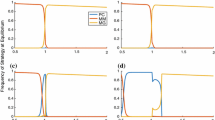Abstract
Egg trading—the alternating exchange of egg parcels during mating by simultaneous hermaphrodites—is one of the best-documented examples of reciprocity between non-relatives. By offering eggs only to partners who reciprocate, traders increase their reproductive success in the male role, but at a potential cost of delaying or reducing fertilisation of their own eggs. Although several authors have considered the evolutionary stability of egg trading once it has evolved, little attention has been paid to how egg trading can invade a population in the first place. We begin to tackle this problem by formally showing that egg trading is under positive frequency-dependent selection: once the proportion of traders in a population exceeds a certain threshold, egg trading will go to fixation. We show that if mate encounters occur frequently, then the cost of withholding eggs from unreciprocating partners is reduced, making it easier for egg trading to evolve. In contrast, the presence of opportunistic ‘streaking’, where unpaired individuals join mating pairs but contribute only sperm, makes it more difficult for egg trading to invade. This is because streakers weaken the link between the number of eggs an individual can offer and its male-role reproductive success.


Similar content being viewed by others
Notes
Computer code for the simulation is provided in the supplementary material online.
References
Anthes N (2010) Mate choice and reproductive conflict in simultaneous hermaphrodites. In: Kappeler P (ed) Animal behaviour: evolution and mechanisms. Springer, Heidelberg, pp 329–357
Anthes N, Putz A, Michiels NK (2005) Gender trading in a hermaphrodite. Curr Biol 15:R792–R793
Anthes N, Putz A, Michiels NK (2006) Sex role preferences, gender conflict and sperm trading in simultaneous hermaphrodites: a new framework. Anim Behav 72:1–12
Axelrod R, Hamilton WD (1981) The evolution of cooperation. Science 211:1390–1396
Bschary R (2010) Cooperation between unrelated individuals—a game theoretic approach. In: Kappeler P (ed) Animal behaviour: evolution and mechanisms. Springer, Heidelberg, pp 213–240
Charnov EL (1979) Simultaneous hermaphroditism and sexual selection. Proc Natl Acad Sci USA 76:2480–2484
Clutton-Brock T (2009) Cooperation between non-kin in animal societies. Nature 462:51–57
Connor RC (1992) Egg-trading in simultaneous hermaphrodites: an alternative to Tit-for-Tat. J Evol Biol 5:523–528
Crowley PH, Hart MK (2007) Evolutionary stability of egg trading and parceling in simultaneous hermaphrodites: the chalk bass revisited. J Theor Biol 246:420–429
Eppley SM, Jesson LK (2008) Moving to mate: the evolution of separate and combined sexes in multicellular organisms. J Evol Biol 21:727–736
Fischer EA (1981) Sexual allocation in a simultaneously hermaphroditic coral reef fish. Am Nat 117:64–82
Fischer EA (1984) Egg trading in the chalk bass, Serranus tortugarum, a simultaneous hermaphrodite. Z Tierpsychol 66:143–151
Fischer EA (1988) Simultaneous hermaphroditism, tit-for-tat, and the evolutionary stability of social systems. Ethol Sociobiol 9:119–136
Fischer EA, Petersen CW (1987) The evolution of sexual patterns in the seabasses. BioScience 37:482–489
Friedman JW, Hammerstein P (1991) To trade, or not to trade; that is the question. In: Selten R (ed) Game equilibrium models I: evolution and game dynamics. Springer, Berlin, pp 257–275
Hamilton WD (1964) The genetical evolution of social behaviour. I. J Theor Biol 7:1–16
Hart MK, Shenoy K, Crowley PH (2011) Sexual conflicts along gradients of density and predation risk: insights from an egg-trading fish. Evol Ecol 25:1081–1105
Heath DJ (1977) Simultaneous hermaphroditism; cost and benefit. J Theor Biol 64:363–373
Hutchinson JMC, Waser PM (2007) Use, misuse and extensions of “ideal gas” models of animal encounter. Biol Rev 82:335–359
Jarne P, Auld JR (2006) Animals mix it up too: the distribution of self-fertilization among hermaphroditic animals. Evolution 60:1816–1824
Jennions MD, Petrie M (2000) Why do females mate multiply? A review of the genetic benefits. Biol Rev Camb Philos Soc 75:21–64
Kokko H, Brooks R, Jennions MD, Morley J (2003) The evolution of mate choice and mating biases. Proc R Soc B 270:653–664
Landolfa MA (2002) On the adaptive function of gamete trading in the black hamlet Hypoplectrus nigricans. Evol Ecol Res 4:1191–1199
Lehtonen J, Kokko H (2012) Positive feedback and alternative stable states in inbreeding, cooperation, sex roles and other evolutionary processes. Philos Trans R Soc Lond B 367:211–221
Leonard JL (1990) The hermaphrodite’s dilemma. J Theor Biol 147:361–372
Leonard JL, Lukowiak K (1984) Male-female conflict in a simultaneous hermaphrodite resolved by sperm trading. Am Nat 124:282–286
Neff BD, Pitcher TE (2005) Genetic quality and sexual selection: an integrated framework for good genes and compatible genes. Mol Ecol 14:19–38
Noë R (2001) Biological markets: partner choice as the driving force behind the evolution of mutualisms. In: Nöe R, van Hooff JARAM, Hammerstein P (eds) Economics in nature: social dilemmas, mate choice and biological markets. Cambridge University Press, Cambridge, pp 93–118
Nowak MA (2006) Fives rules for the evolution of cooperation. Science 314:1560–1563
Petersen CW (1995) Reproductive behavior, egg trading, and correlates of male mating success in the simultaneous hermaphrodite, Serranus tabacarius. Environ Biol Fishes 43:351–361
Petersen CW (2006) Sexual selection and reproductive success in hermaphroditic seabasses. Integr Comp Biol 46:439–448
Puurtinen M, Kaitala V (2002) Mate-search efficiency can determine the evolution of separate sexes and the stability of hermaphroditism in animals. Am Nat 160:645–660
Sachs JL, Mueller UG, Wilcox TP, Bull JJ (2004) The evolution of cooperation. Q Rev Biol 79:135–160
Sella G, Lorenzi MC (2000) Partner fidelity and egg reciprocation in the simultaneously hermaphroditic polychaete worm Ophryotrocha diadema. Behav Ecol 11:260–264
Sella G, Premoli MC, Turri F (1997) Egg trading in the simultaneously hermaphroditic polychaete worm Ophryotrocha gracilis (Huth). Behav Ecol 8:83–86
Silk JB (2013) Reciprocal altruism. Curr Biol 23:R827–R828
Taborsky M (2013) Social evolution: reciprocity there is. Curr Biol 23:R486–R488
Trivers RL (1971) The evolution of reciprocal altruism. Q Rev Biol 46:35–57
Vreys C, Michiels NK (1998) Sperm trading by volume in a hermaphroditic flatworm with mutual penis intromision. Anim Behav 56:777–785
West SA, Pen I, Griffin AS (2002) Cooperation and competition between relatives. Science 296:72–75
Acknowledgments
We would like to thank two anonymous reviewers for their thoughtful comments and criticisms. Funding was provided by the Australian Research Council and an Australian Postgraduate Award.
Author information
Authors and Affiliations
Corresponding author
Electronic supplementary material
Below is the link to the electronic supplementary material.
Rights and permissions
About this article
Cite this article
Henshaw, J.M., Jennions, M.D. & Kokko, H. The Economics of Egg Trading: Mating Rate, Sperm Competition and Positive Frequency-Dependence. Dyn Games Appl 4, 379–390 (2014). https://doi.org/10.1007/s13235-014-0107-1
Received:
Accepted:
Published:
Issue Date:
DOI: https://doi.org/10.1007/s13235-014-0107-1




